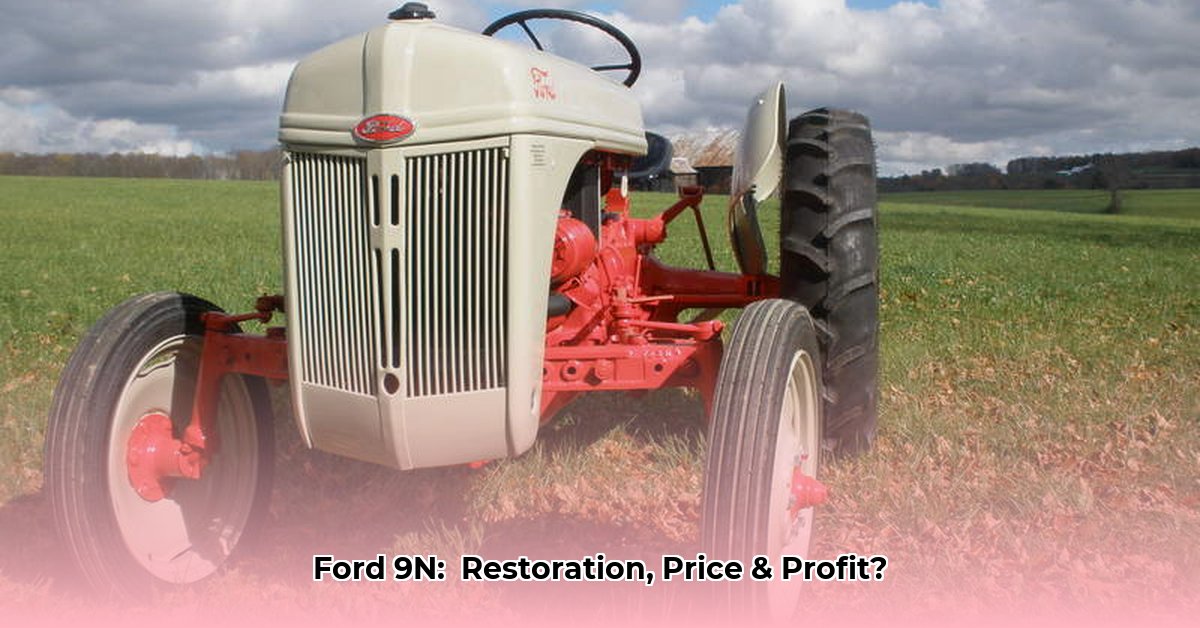
The Ford 9N tractor, a stalwart of American farming from the late 1930s and early 1940s, remains a highly sought-after collectible. This guide provides a comprehensive overview, assisting both seasoned enthusiasts and newcomers in navigating the world of Ford 9N ownership, restoration, and investment. From understanding market pricing to performing a thorough inspection and even assessing the investment potential, we cover it all. For detailed specifications, check out these Ford tractor specs.
Decoding the Ford 9N Market: Price, Condition, and More
The Ford 9N's value is surprisingly dynamic, ranging from a few thousand dollars for a project tractor to well over $13,000 for a meticulously restored showpiece. This significant price range reflects the impact of various factors:
Condition: A fully restored tractor commands a premium compared to one needing significant work. Think of it like a classic car—a pristine example will always be more valuable than a neglected project.
Year of Manufacture: Subtle variations across the years of production impact value. Certain model years are more desirable among collectors.
Accessories: Original implements (plows, cultivators, etc.) significantly increase the tractor's value and desirability. These functional additions speak to the tractor's original use and its historical context.
Completeness: Missing parts severely depreciate the value. Finding replacement parts can be challenging and expensive. A complete tractor is worth considerably more than one with missing or broken components.
Rarity of Features: Some rarer features or options add to a tractor's appeal. This is similar to finding a collector's edition vehicle with a rare paint color or a limited-edition package.
Understanding these factors is paramount to making a sound investment. Market research is crucial; prices fluctuate frequently. Let's now focus on acquiring your own piece of history.
Buying Your Ford 9N: A Step-by-Step Guide
Pre-Purchase Inspection: A Critical First Step: A thorough inspection is non-negotiable. This isn't just a quick visual; meticulous scrutiny is key. This checklist will guide you:
Engine: Listen for unusual noises, check for leaks (oil, coolant, fuel), and assess compression.
Transmission: Test all gears for smooth shifting; grinding or unusual sounds indicate potential problems.
Hydraulics (if equipped): Check the lift mechanism for leaks. This is crucial for functionality.
Electrical System: Verify the functioning of lights, gauges, and other electrical parts.
Body: Inspect for rust, dents, and other damage. Remember, extensive rust can be costly to repair and may compromise structural integrity.
Tires: Assess tire condition and inflation. Factor in potential costs for new tires.
Accessories: Note any included implements; these contribute significantly to value.
Negotiating the Price: Finding Fair Market Value: Research recently sold comparable Ford 9Ns to establish a benchmark. Consider condition, needed repairs, and the value of any accessories. Don't hesitate to negotiate; a fair price reflects the tractor's true condition.
Authenticity Verification: Ensuring Genuine History: Use online resources and Ford 9N enthusiast forums (such as myfordtractors.com) to verify the tractor's serial number and cross-check it with other components' casting dates. This helps confirm its authenticity.
Legal Considerations: Protecting Your Investment: Ensure ownership documentation is complete and legally sound. Consult local resources to understand legal requirements specific to your region concerning the purchase and transport of vintage vehicles.
Ford 9N Restoration: A Guide to Reviving History
Restoring a Ford 9N is a labor of love (and expertise). Careful planning is essential.
Parts Sourcing: Original parts are scarce and expensive. Aftermarket parts are more readily available but may not meet purist standards.
Common Issues: Expect to address engine rebuilds, transmission repairs, and rust.
Professional Help: Consider hiring a specialized mechanic or restoration expert, especially if you lack experience with vintage machinery.
Investing in a Ford 9N: Potential Returns
The Ford 9N market offers potential for collectors and investors alike. Remember, market fluctuations exist. Thorough research is key.
| Stakeholder | Short-Term Strategy | Long-Term Strategy |
|---|---|---|
| Collectors/Buyers | Meticulous inspection, strategic negotiation, market research. | Track market trends, target high-demand configurations. |
| Restorers/Mechanics | Specialize, build parts inventory, effective marketing. | Partner with buyers and sellers, build a strong reputation. |
| Sellers/Auctioneers | Accurate descriptions, effective online presence. | Implement robust authenticity verification processes. |
Risk Assessment: Potential Pitfalls
Buying a vintage tractor involves inherent risks. Understanding these risks and planning accordingly is imperative.
| Risk Factor | Probability | Impact | Mitigation |
|---|---|---|---|
| Mechanical Failure | High | High | Thorough inspection, pre-purchase mechanical evaluation, budget for repairs. |
| Parts Availability | Moderate | Moderate | Develop parts resources, consider aftermarket options. |
| Authenticity Concerns | Moderate | Moderate | Verify serial numbers, research the tractor's history thoroughly. |
| Market Volatility | Low | Low | Diversify investments, budget appropriately. |
| Restoration Cost Overruns | High | High | Detailed plans, multiple quotes, contingency funds. |
Investing in a Ford 9N can be rewarding, blending mechanical skill, historical appreciation, and financial potential. However, success hinges on thorough planning, research, and due diligence. Remember: proper preparation prevents poor performance.